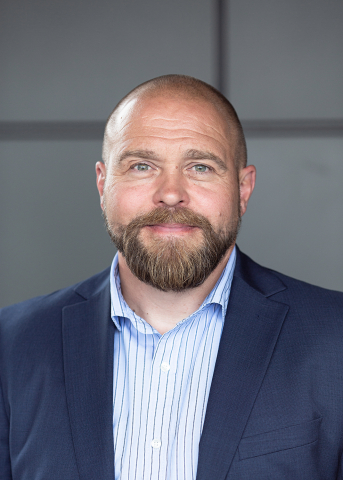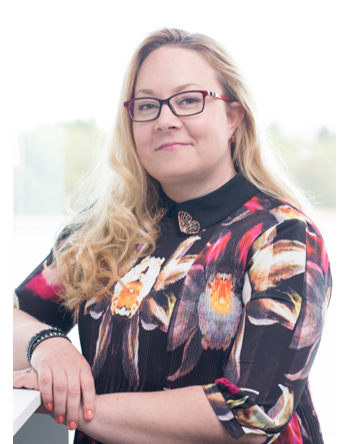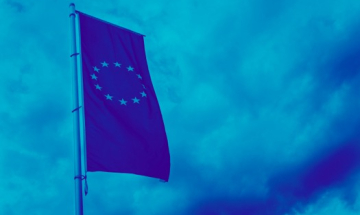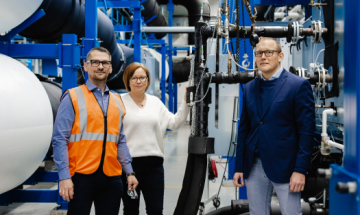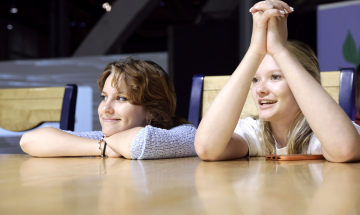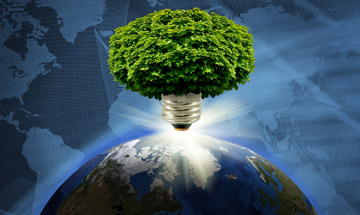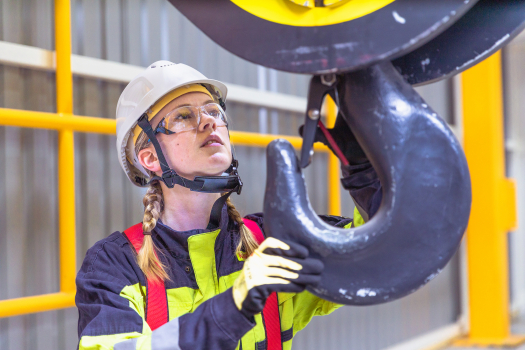
The circular economy is a part of everyday business for crane manufacturer Konecranes: “The circular economy is more than just a competitive asset, it is the only way forward”
Konecranes’ largest harbour cranes are taller than the Tower of the Helsinki Olympic Stadium, but the company manufactures a wide range of cranes and hoists. Industrial or harbour cranes are mostly made from steel, and the steel structures are entirely recyclable.
Work begins on the drawing board to calculate the longest possible service life for cranes and hoists. Konecranes has participated in making the circular economy programme led by Technology Industries of Finland for the technology sector. Does the company believe that the circular economy is a significant business factor for the future?
“Why wouldn’t it?” says Mika Viro, Director, Service EMEA North-East at Konecranes.
“The world is ready for it. Here in Finland – and in many other countries – we already have our own climate goals. The goals may differ from one market or country to the next, but it has been clear for some time that every responsible company must be involved in this transformation. We need to take action to save the planet”, Viro says.
The circular economy is an integral part of the company’s everyday business – it is more than just a competitive asset.
“For us, the circular economy is more of a way we operate– the only way that Konecranes can move forward. We reckon that we need to be involved in this.”
Double or triple the service life of equipment
The circular economy is often confused with recycling, but the circular economy starts at the design stage and takes into consideration the product’s entire life cycle, from the drawing board to the end of life.
“Konecranes’ approach to maintenance is to proactively keep equipment in working condition, before any parts fail or break down. . This extends their life cycle systematically. The first steps were taken back in the 1960s. In the 1980s and 1990s, the service business in Finland shifted significantly to preventive maintenance, meaning that .the transition from reactive to preventive measures , allowing us to systematically extend the service lives of machinery”, Viro says.
Going forward with the circular economy. “For us, the circular economy is more of a way we operate– the only way that Konecranes can move forward. We reckon that we need to be involved in this”, says Mika Viro.
Nowadays we talk about predictive maintenance. In the simplest terms, this means that when the design life of the device and all its components are known, and taking into consideration the equipment usage, it is possible to calculate the wear and tear ageing of devices equipment accurately. It is also possible to calculate when the components will need to be replaced or the device refurbished.
“Devices send usage data, and we collect their maintenance data. All this information is analysed, and accurate analyses and forecasts are prepared. We use these as a basis for drawing up highly detailed forecasts for the coming years to enable timely modernisations and repairs By working systematically over the long term, we can double or even triple the service lives of the equipment.”
“In other words, with a bit of streamlining, performing the right maintenance at the right time, optimising equipment life cycle, and increasing the handprint we are able to reduce waste”, Viro summarises.
The circular economy generates added business value
The circular economy integrates effectively with Konecranes’ ambitious climate goals and product offering, says Satu Kaivonen, Sustainability Manager.
“We are reducing our total emissions and purchasing renewable electricity, but we will need circular economy solutions in order to reach our own ambitious climate goals. We have as many as 33 different circular economy strategies in place, but we are still exploring new opportunities”, she says.
At the epicentre of extending service lives. “At its core, Konecranes’ circular economy work is about extending the total service lives of cranes, ensuring the sustainability of materials used in cranes, and boosting energy efficiency”, says Satu Kaivonen.
However, climate and circular economy actions do not just save natural resources. They are more than mere climate action.
“In the context of the circular economy, we are also talking about major cost savings, so there is also business value to be gained. Our message to customers is that since they have climate goals of their own, we can estimate the scale of emissions savings that our products and services can contribute to their climate goals”, Mika Viro explains.
Konecranes’ customers are expanding their carbon handprints, and we are playing an increasingly active role in facilitating this improvement. The carbon handprint describes the positive environmental impacts that the company’s products and services bring for its customers and its customers’ customers.
“For example, in harbour equipment our focus is specifically on increasing the handprint impact”, Viro says.
It is possible to achieve significant handprint impacts by the selection of power sources.
“We can convert existing diesel-powered harbour equipment into hybrid or fully electric equipment. The reduction in carbon dioxide emissions can be as much as 60–80 per cent”, Kaivonen says.
The circular economy transition calls for new expertise
According to Mika Viro, the circular economy is becoming an integral value of Konecranes’ products and everyday business operations in the same way as occupational safety.
“Konecranes Service’s entire business supports the circular economy because it is already integrated into our service model and product design. The easiest way to demonstrate the significance of the circular economy in terms of net sales is to focus on our service business”, Satu Kaivonen adds.
- At the forefront of the world’s most sustainable companies
-
- Konecranes is one of the largest companies in Finland. It manufactures industrial and harbour cranes and offers maintenance services for them. In 2021, the Group recorded net sales of EUR 3.2 billion. The company has approximately 16,500 employees in 50 countries. The headquarters are located in Hyvinkää.
- Konecranes has set Science-Based climate targets.
- The company has been awarded a gold rating by EcoVadis, the world’s largest provider of business sustainability ratings. Thanks to its actions, practices and reporting, the company is in the top four per cent of all of the rated businesses in the world.
- The circular economy accounts for 35 per cent of the company’s business.
- Konecranes was founded in 1984, and it was previously part of KONE Corporation.
Circular economy and sustainable development requirements are also reflected in customers’ wishes.
“They can definitely be seen in customer wishes. The challenge for many companies is that they have ambitious roadmaps and strategies that have not been fully implemented into procurement, which is usually about optimising finances rather than the carbon handprint or the circular economy impact. There is still a transformation to come here, although companies are otherwise taking good, tangible climate action”, Viro says.
The transition to the circular economy requires companies to adopt a new mindset and expertise.
“When a company decides to experiment with some type of circular economy business model, the capabilities must be enhanced to the extent necessary for the model to work in practice. Firstly, the company needs skills in change management, as the revenue streams come from different sources, job descriptions may change, and capabilities need to be built to support the new way to operate”, Satu Kaivonen says.
The circular economy transition affects every member of staff, but the critical factor is management and managerial success, says Mika Viro.
The circular economy transition affects every member of staff, but the critical factor is management and managerial success.
“The most important thing is to understand the big picture. Before you are ready to change the way you work, you need to understand why you are changing it. If there is no change in attitudes and understanding, the line management is not working.”
New expertise is required in fields such as analysing data and calculating the carbon footprint and handprint.
“Improving the quality and analysis of the collected data are crucial factors”, Kaivonen says. Viro continues:
“Every company has been collecting data for years. Now it is time to begin refining and analysing it for the good of the circular economy and expanding the carbon handprint. For example, there is much talk of digital twins – a really interesting field – which help to simulate processes and operating methods and avoid concrete activities that would consume energy or global resources. This offers enormous potential to companies by providing them with accurate, timely data.”
Both praise the standard of expertise at technical universities in Finland.
“Last summer, we took on five summer interns specialising in sustainability and life cycle assessment calculation. Four of them continue to work with us, and we could not be happier. They have amazing expertise and very interesting ways of thinking and challenging us to approach things in a new and different way”, Kaivonen says.
The state need a better understanding of innovations
Konecranes is performing well in global markets with its existing products and services, but various business units are constantly developing new things with their own research and development teams, as well as in cooperation with start-ups and other entities.
The various business units are constantly developing new things with their own research and development teams, as well as in cooperation with start-ups and other entities.
Kaivonen and Viro would like the State to have a better understanding of investments in new products and services. Innovations are expected to generate substantial sales and export revenues, even though they are still in the early phases of development and seeking funding.
“There are further challenges in resourcing and advice on project funding. Every company needs to use its own resources to work out how to apply for funding and how things should be presented. If companies do not have any employees who are specialised in such applications, they may not apply at all”, Viro says.
A large amount of new legislation on the circular economy is expected in the coming years. The EU is working on a digital product passport, which will be presented as a new tool for promoting the circular economy.
“The idea is a good one. However, it should be possible to implement reforms like this in collaboration with businesses to avoid denting the competitiveness of companies while promoting recycling and the circular economy.”
Text: Marjo Ollikainen
Photos: Konecranes
